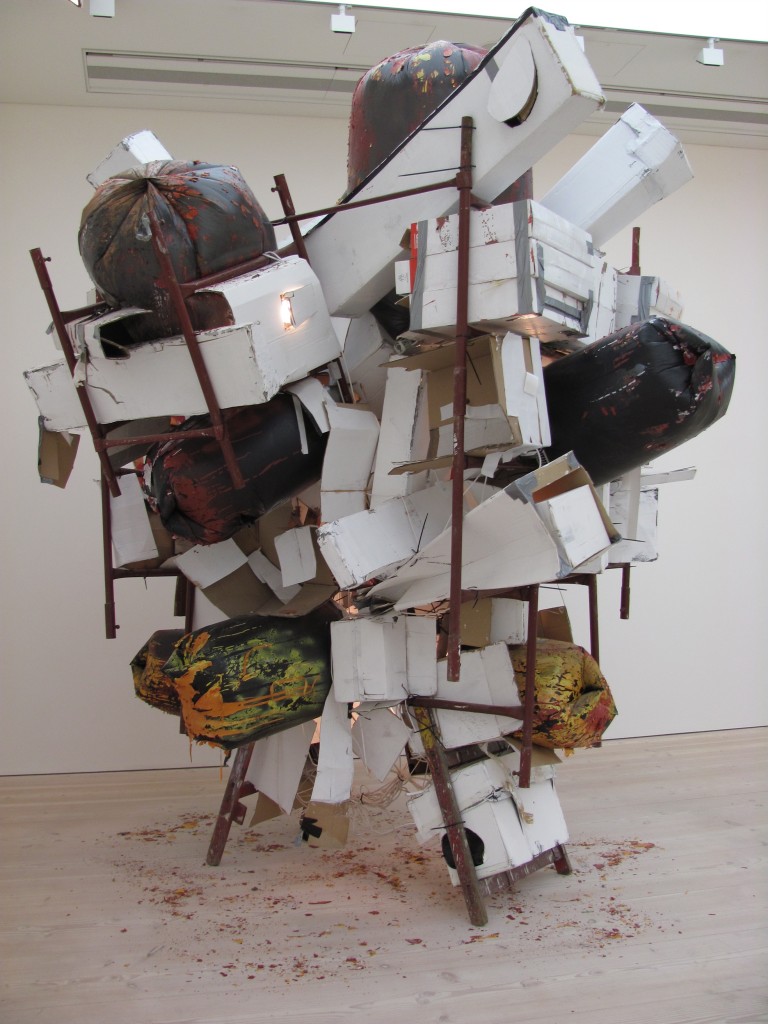by Mary Virginia Cooley
On Friday, January 7th of our first week in London, our sufficiently dampened class made its way along the Underground to a stop at Sloane Square in Chelsea. Near the square were the Royal Court Theatre and the St. Thomas Moore Language College. The area also included some retail locations, from hairdressers and clothing shops to a computer repair shop. Just south of the square itself, the Saatchi Gallery sat tucked away from King Street with an expansive, green lawn at its front. A white peak and several smooth columns framed the entrance to the gallery, which was founded by in 1985 Charles Saatchi: an art collector who wanted a place to display his extensive collection of contemporary art. Entrance is free and open to the public, while a pink guidebook is available for a small fee. The exhibit currently on display, Newspeak: British Art Now Part II, is hard to view as a statement on British identity. It seems instead to stand as a testament to subverted expectations as its many paintings, photographs, and other installations could rarely be called expected.
Finding myself attracted mainly to sculpture, one piece that both amused me heartily and seemed to epitomize this idea of the false front was Graham Hudson’s “All My Exes Live In Tesco’s” (2007). This sculpture is a monstrous work, filling the entire corner of Gallery 4 at an astonishing 550 x 250 x 250 cm. Beyond the ladder that Hudson uses as a frame, however, his great construction is simply a pile of trash bags and cardboard boxes, painted in fiery hues, taped together, and puffed up by a collection of circular fans. On his installation, Hudson notes, “I was interested in how you can make a really big thing out of nothing.”
The entire swollen beast gives off a wild, electric hum and quivers as it fills with artificial breath. It is kept alive by a small umbilical cord protruding from its back, keeping its many fans running. As a result of this fragility, an enthusiastic young museum-goer not watching his feet could easily return the whole production to a sadly deflated state. With a great many chips of paint having fallen off of Hudson’s piece onto the floor (from the vibration of the fans, or perhaps as the result of those careless feet), it seems to already be showing the strain of maintaining such a massive presence. In contrast to the chipped paint I observed, an older photo on the Saatchi’s website shows the work displayed on a clean floor with paint still intact.
The amusement I derived from “All My Exes Live in Tesco’s” came mostly from the work’s title, which prompted an involuntary chuckle when I read it the first time. Though ignorant of George Strait’s awful country song, “All My Exes Live in Texas” (1987), the lone star state instantly came to mind. (Feel free to give it a listen if you haven’t heard it or need a refresher.) Bearing its moniker in mind, it is possible “All My Exes Live in Tesco’s” represents the inner tension of a middle or upper class person ashamed to have a lower class background. With a figurative romantic history at the lower-end grocery chain Tesco’s acting as the artist’s exposed electrical cord, his identity might be seen as a colorful facade of distinction: beautiful and immense, but always on the verge of collapse. With the Texas-Tesco’s allusion, though, Hudson seems to be calling Americans the cheaper, less cultured version of the British.
Other such unexpected surprises included Tessa Farmer’s “Swarm” (2004), in which small fairies reign as oppressive, skeletal overlords in a universe of winged insects. Jonathan Wateridge’s series of over-sized, photorealist oils of impressive looking scenes turned out to be constructed of surprisingly unromantic, everyday objects (spaceships made of milk cartons, twisted hangers and the like in “Space Program,” for instance) while Anne Hardy’s brilliantly colored photographs depict rooms constructed artificially in her studio whose stunning visuals threaten to collapse if viewed from other angles. Peppered throughout the gallery sat clusters of young artists, their sketchbooks open to capture their impressions of the work in front of them. As it was announced last year that the gallery would be donated to the public so it might continue displaying contemporary art in times to come, perhaps some of these students will someday see their own work within the Saatchi’s walls.

